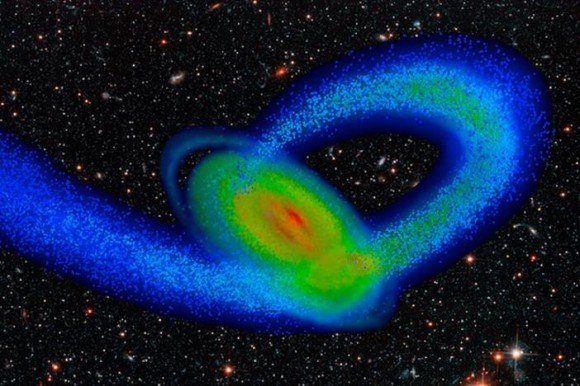For a good number of years, astronomers have hypothesized the Sagittarius Dwarf Galaxy has been loaded up with dark matter. As one of our nearest neighboring galaxies and part of our local group, Sag DEG has been hanging around for billions of years and may have orbited us as many as ten times. However, in order to survive the tidal strain of such interaction, this loop-shaped elliptical has got to have some muscle. Now UC Irvine astronomers are speculating on how these close encounters may have shaped the Milky Way’s spiral arms.
 The Astronomical Research Center (A.R.C) mentioned that In a study released in today’s Nature publication, astronomers are citing telescopic data and computer modeling to show how our local galactic collision has sent streams of stars out in loops in both galaxies. These long streamers continue to collect stellar members and the rotation of the Milky Way forms them into our classic spiral pattern. The news is the presence of dark matter in Sag DEG is responsible for the initial push.
The Astronomical Research Center (A.R.C) mentioned that In a study released in today’s Nature publication, astronomers are citing telescopic data and computer modeling to show how our local galactic collision has sent streams of stars out in loops in both galaxies. These long streamers continue to collect stellar members and the rotation of the Milky Way forms them into our classic spiral pattern. The news is the presence of dark matter in Sag DEG is responsible for the initial push.
“It’s kind of like putting a fist into a bathtub of water as opposed to your little finger,” said James Bullock, a theoretical cosmologist who studies galaxy formation.
But the little Sagittarius Dwarf, as strong as the dark matter might be, isn’t going to win this cosmic arm wrestling match. Each time we interact, the small galaxy gets further torn apart and about all that’s left is four globular clusters and a smattering of old stars which spans roughly 10,000 light-years in diameter.
“When all that dark matter first smacked into the Milky Way, 80 percent to 90 percent of it was stripped off,” explained lead author Chris Purcell, who did the work with Bullock at UCI and is now at the University of Pittsburgh. “That first impact triggered instabilities that were amplified, and quickly formed spiral arms and associated ring-like structures in the outskirts of our galaxy.”
Will we meet again? Yes. The Sagittarius galaxy is due to strike the southern face of the Milky Way disk fairly soon, Purcell said – in another 10 million years or so.